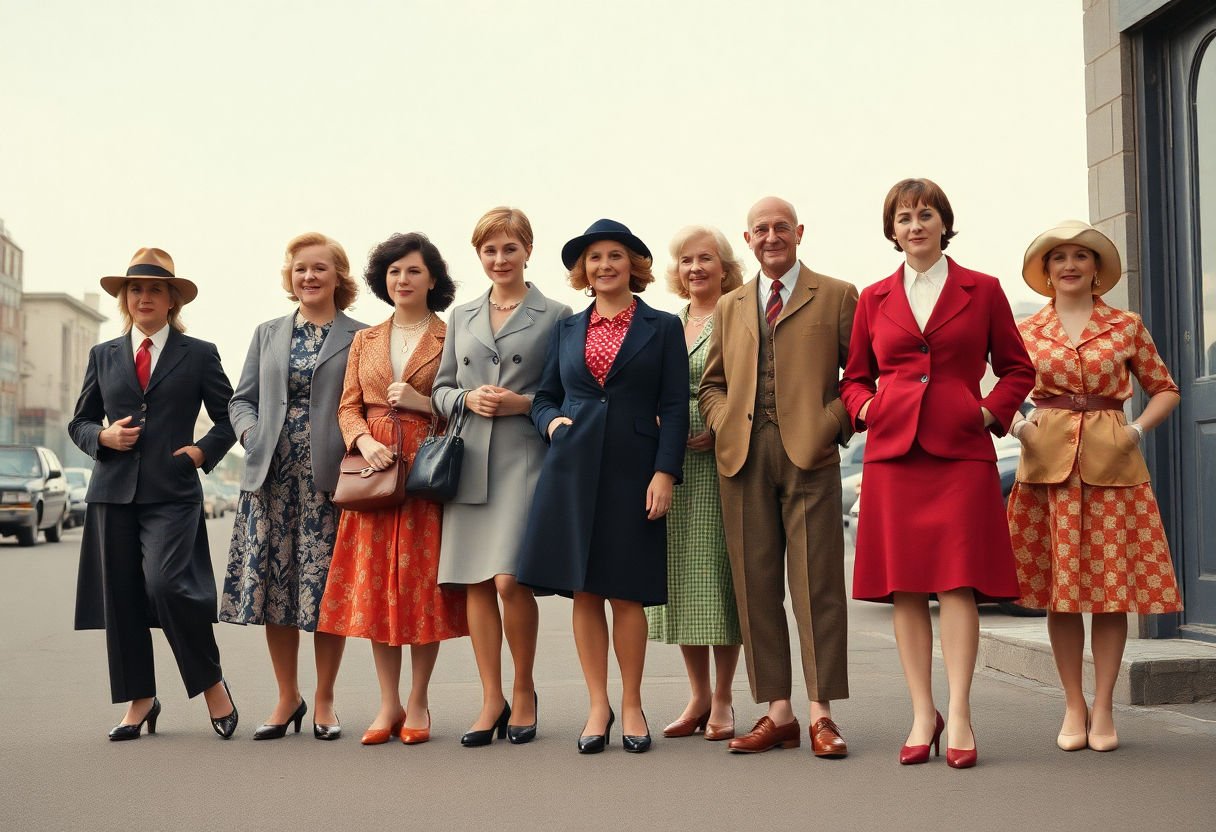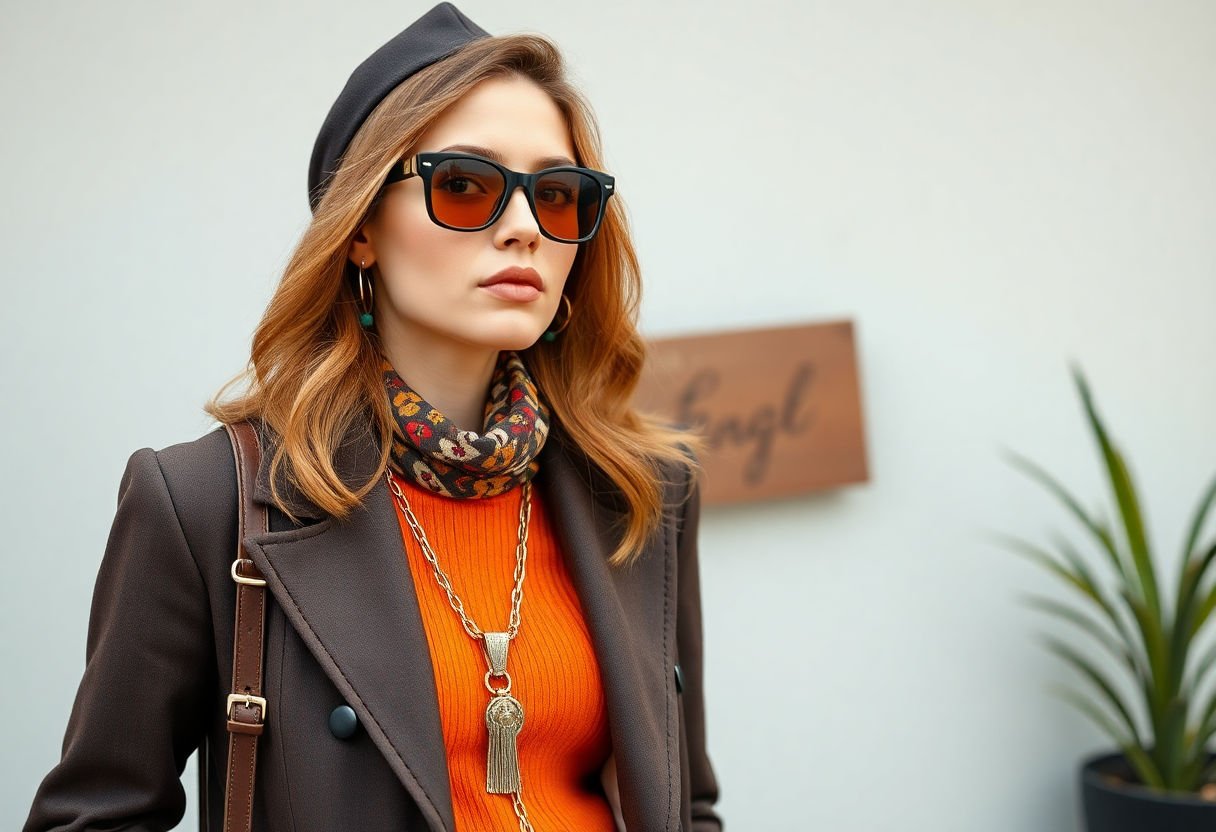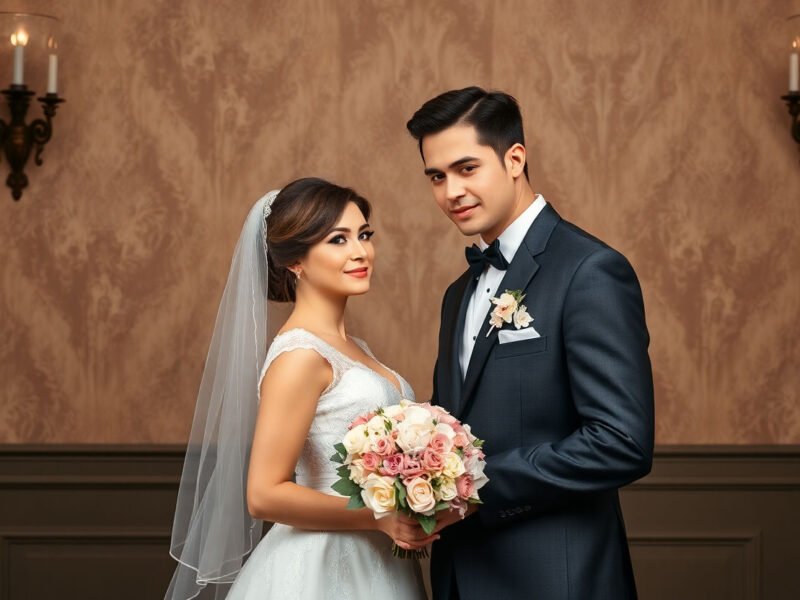The resurgence of vintage chic and old money outfits on Pinterest highlights the timeless allure of classic fashion. These styles, defined by their elegance and sophistication, merge seamlessly with modern trends, showcasing a deep appreciation for superior craftsmanship and distinctive design. Pinterest acts as a catalyst, spreading these enduring styles across a global audience, while offering innovative ways to infuse vintage elements into contemporary wardrobes. This exploration into vintage fashion not only supports sustainable practices but also celebrates iconic figures who have left an indelible mark on style. Dive into the allure of vintage chic and discover how to incorporate these elements into your wardrobe.
Key Takeaways
- Vintage chic and old money outfits are characterized by their elegance, sophistication, and use of high-quality materials.
- Pinterest acts as a powerful tool in disseminating and influencing vintage and old money fashion trends on a global scale.
- Essential aspects of old money fashion include tailored silhouettes, classic color palettes, and timeless accessories.
- Incorporating vintage elements into modern wardrobes allows for sustainable fashion choices while maintaining a unique personal style.
- Historical figures and celebrities have played a significant role in popularizing old money styles, further solidifying their place in modern fashion.
The Timeless Appeal of Old Money Fashion

Old money fashion is renowned for its enduring elegance and refined sophistication. Rooted deeply in history, it echoes a sense of timelessness that transcends fleeting trends. Characterized by understated luxury and the use of high-quality materials, old money fashion draws from a heritage of style where subtlety is key. Unlike fast fashion, it emphasizes pieces that age gracefully, becoming more treasured with time.
This sartorial tradition began to take shape in the late 19th century, when wealth was often generational and style was synonymous with discretion and taste. The focus was on expertly tailored silhouettes, ensuring a perfect fit that flattered without the need for ostentation. Neutral and muted color palettes such as navy, cream, and gray dominated, reflecting both sophistication and versatility.
Old money fashion also places significance on heritage brands known for craftsmanship, such as Hermès, Burberry, and Ralph Lauren. These brands epitomize a commitment to exceptional materials and enduring designs. Accessories play a subtle yet essential role, with pieces like pearl earrings, leather loafers, and silk scarves adding a touch of refinement without overpowering the ensemble.
Renowned for its ability to imbue wearers with a sense of quiet confidence, old money fashion continues to influence modern style. It is not driven by the desire to showcase wealth, but rather to emphasize a cultivated aesthetic where quality and class prevail. This timeless appeal resonates with individuals seeking to blend tradition with personal expression in today’s fashion landscape.
How Pinterest Shapes Fashion Trends

Pinterest has emerged as a formidable force in the fashion industry, shaping trends and amplifying the reach of vintage chic and old money outfits. This platform serves as a vast digital inspiration board, where users actively curate collections that reflect their sartorial aspirations. The visual nature of Pinterest makes it an ideal medium for fashion enthusiasts to discover and engage with timeless styles.
One of the ways Pinterest influences fashion trends is through its sophisticated algorithm, which suggests content based on user preferences. By analyzing patterns and user interactions, it showcases vintage chic looks and old money aesthetics to a broader audience, thus driving their popularity. This personalized experience enables users to embrace timeless fashion by seamlessly integrating these influential styles into their everyday lives.
Pinterest also facilitates the spread of fashion trends globally. Users from different cultural backgrounds and geographical locations contribute to a diverse collection of vintage-inspired boards, fostering a global appreciation for old money fashion. This cross-cultural exchange broadens the understanding of classic styles and introduces new interpretations that resonate with modern audiences.
Furthermore, Pinterest acts as an educational tool. With access to countless images and descriptions, users can learn about the defining characteristics of old money outfits. It enables individuals to make informed choices about incorporating vintage elements into their wardrobes.
In essence, Pinterest is not just a platform for showcasing fashion; it is a dynamic community that continuously shapes the ever-evolving landscape of style. Its influence ensures that the elegance and sophistication of vintage chic remain relevant and inspiring for generations to come.
Essential Elements of Old Money Outfits

Tailored Silhouettes
At the heart of old money fashion lies the principle of impeccable tailoring. Each garment is crafted to fit the body perfectly, showcasing understated elegance and sophistication. Tailored silhouettes create a polished look that inadvertently commands attention without demanding it. Whether it’s a sharp blazer, a well-fitted trench coat, or a classic pencil skirt, the essence of tailored pieces reflects a commitment to quality and refinement, echoing the ethos of timeless style.
Classic Color Palettes
A defining characteristic of old money outfits is their reliance on classic color palettes. Soft neutrals, deep jewel tones, and understated hues dominate the wardrobe. These colors transcend seasonal trends, offering versatility and a sense of understated luxury. Shades like navy, cream, camel, and burgundy are recurrent favorites, chosen for their ability to blend seamlessly with a variety of ensembles, enhancing both daytime and evening attire.
Timeless Accessories
The accessories that accompany old money outfits serve as subtle yet powerful statements of elegance. Pearls, leather belts, and structured handbags are quintessential components that add depth and richness to an ensemble. These accessories are meticulously selected to complement the sophisticated simplicity of the attire. Quality over quantity is the guiding principle, ensuring each accessory is a lasting investment rather than a fleeting trend.
Rich Fabrics and Textures
Luxury is woven into every fiber of old money fashion through the use of rich fabrics and textures. Cashmere, silk, tweed, and wool are frequently found in these wardrobes, chosen for their durability and luxurious feel. These materials not only provide comfort and warmth but also exude an air of effortless elegance, a hallmark of the old money aesthetic.
Iconic Vintage Chic Styles

In the journey through fashion history, certain vintage styles remain as iconic today as they were in their heyday. The allure of these styles is rooted in their ability to transcend time, offering a glimpse into an era while maintaining a relevance in contemporary wardrobes.
The Roaring 20s, characterized by its daring flapper dresses and beaded elegance, introduced styles that were both liberating and glamorous. The iconic drop-waist dresses of this era, often adorned with intricate beadwork, are celebrated for their bold rebellion against previous fashion constraints.
Transitioning into the Elegant 50s, fashion saw a return to an ultra-feminine silhouette, popularized by figures such as Audrey Hepburn and Grace Kelly. The timeless appeal of nipped-in waists and full skirts epitomized sophistication and class. Evening gowns from this decade, with their classic lines and understated elegance, continue to inspire designers today.
During the Swinging 60s, fashion took an adventurous turn with the mod style. Think of A-line dresses featuring bold prints and vibrant colors that symbolized youthful exuberance and a break from tradition. Jackie Kennedy’s clean-cut fashion choices during this time, particularly her chic suits and pillbox hats, encapsulated the essence of vintage chic.
Each of these eras offers a unique inspiration, allowing fashion enthusiasts to express individuality through historical elegance. Embracing these storied styles not only enriches one’s personal fashion narrative but also honors the artistry and cultural shifts of the past. Whether through minimalist beads of the 20s or the structured elegance of the 50s, vintage chic remains a testament to enduring style.
Integrating Vintage into Modern Wardrobes

Integrating vintage elements into a modern wardrobe allows you to create a unique look that exudes both individuality and timeless elegance. Begin by embracing classic accessories. Adding vintage scarves, brooches, or handbags can instantly elevate a contemporary outfit. For instance, a 1950s silk scarf can be draped elegantly over a tailored blazer, providing a subtle nod to the past.
When it comes to clothing, consider blending vintage tops with modern bottoms for a balanced ensemble. Pairing a vintage blouse with a sleek pair of high-waisted jeans creates a look that is both sophisticated and versatile. Similarly, mixing in vintage skirts with contemporary tops offers a refreshing take on classic styles.
A color palette rooted in neutrals and muted tones is often synonymous with vintage chic and old money aesthetics. Weaving these colors into your wardrobe enhances its overall cohesiveness. A taupe pencil skirt or a charcoal wool coat effortlessly complements modern apparel, ensuring a seamless blend.
Incorporating vintage jewelry into your everyday style can also add character. Whether it’s an heirloom pearl necklace or antique gold earrings, these pieces imbue an outfit with elegance and history without overpowering your modern look.
In exploring vintage chic, remember to maintain your personal fashion identity. You can achieve this by selecting items that resonate with your style ethos. This approach ensures that your wardrobe feels curated and distinctly yours, harmonizing the old with the new to create a look that is both modern and timeless.
Sustainability and Vintage Fashion
Vintage fashion is not only a tribute to the elegance of past decades but also a powerful ally in the pursuit of environmental sustainability. By opting for pre-loved and vintage garments, fashion enthusiasts contribute significantly to reducing the demand for new clothing production, which is often resource-intensive and environmentally harmful.
Environmental Benefits:
- Resource Conservation: Choosing vintage reduces the need for raw materials. It cuts down on the water, energy, and chemicals typically required in textile manufacturing.
- Reduction in Waste: Vintage shopping minimizes textile waste. A staggering amount of clothing ends up in landfills annually, but extending the life of garments through vintage fashion helps curb this trend.
- Decreased Carbon Footprint: By embracing vintage, individuals can lower their carbon footprint, as the energy and emissions linked to the production of new garments are avoided.
Embracing vintage fashion aligns seamlessly with sustainable styling. It invites fashion enthusiasts to savor high-quality materials and craftsmanship that traditional clothing often embodies. This parallels the “buy less, choose well” philosophy, encouraging consumers to invest in timeless, durable pieces that transcend fleeting trends.
As Vivienne Westwood famously stated, “Buy less, choose well, make it last.” Vintage fashion embraces this ethos, promoting a wardrobe that stands the test of time both in style and impact. By making informed choices, individuals not only embody a chic, old money aesthetic but also champion a future where fashion respects the planet. This harmonious blend of past elegance and modern consciousness makes vintage fashion a key player in sustainable style.
Famous Figures and Old Money Style
Throughout history, old money style has been epitomized by figures who embody sophistication and timeless elegance. These individuals, through their sartorial choices, have shaped the benchmarks of refined fashion across decades.
One of the foremost figures in old money style is Audrey Hepburn. Renowned for her simple yet chic wardrobe, Hepburn’s style is characterized by classic silhouettes and understated luxury. Her affinity for Givenchy and penchant for pearl necklaces set a standard for enduring elegance.
Jackie Kennedy Onassis, another icon, brought American preppy sophistication to the forefront. Her wardrobe featured crisp lines, tailored skirts, and pillbox hats, which have all become synonymous with classic American style. She demonstrated an impeccable ability to blend luxurious simplicity with contemporary trends.
In the world of cinema, Cary Grant remains a benchmark of male old money style. His preference for perfectly tailored suits and polished footwear showcased the quintessential gentleman’s attire. Grant’s style emphasized meticulous attention to detail, setting a high bar for men’s vintage fashion.
On the contemporary front, figures such as Ralph Lauren have integrated the old money aesthetic into popular culture through fashion branding. Lauren’s collections celebrate the American Dream with tailored blazers, equestrian motifs, and a color palette that echoes timeless sophistication.
These celebrity icons have not only defined old money style but have also influenced current fashion trends seen across Pinterest boards. Their timeless looks inspire how today’s fashionistas interpret vintage chic, making old money style perpetually relevant.
Conclusion
The exploration of vintage chic and old money fashion reveals a timeless allure that continues to shape modern trends. As these styles gain traction on Pinterest, they reinforce a growing appreciation for elegance and sustainability in fashion. By incorporating vintage elements into our wardrobes, we not only embrace historical styles but also contribute to environmentally conscious fashion choices. As this trend evolves, consider using Pinterest as a source of inspiration to seamlessly blend classic sophistication into your personal style, fostering a unique aesthetic that honors both tradition and modernity.
Frequently Asked Questions
How can I find authentic vintage pieces on Pinterest?
To discover authentic vintage pieces on Pinterest, utilize specific search terms such as “vintage clothing,” “old money fashion,” or “classic style.” Engage with boards and pins that showcase verified vintage shops.
What are the key characteristics of an old money wardrobe?
An old money wardrobe typically includes high-quality materials, tailored silhouettes, and understated elegance. Focus on classic colors and timeless accessories like pearls or leather goods.
How can I combine vintage elements with modern fashion without clashing?
Integrate vintage elements by mixing them with contemporary basics. Pair a vintage blazer with modern denim or incorporate classic accessories with sleek new styles for a balanced look.
Why is Pinterest ideal for exploring vintage chic fashion?
Pinterest is ideal for this exploration due to its visual nature and vast array of curated content. It allows users to easily collect and organize inspiration from around the world.
Are vintage outfits a more sustainable fashion choice?
Yes, vintage outfits often represent a more sustainable fashion choice as they promote reusing high-quality garments and reducing waste. Embracing vintage fashion contributes to a more eco-friendly wardrobe.



